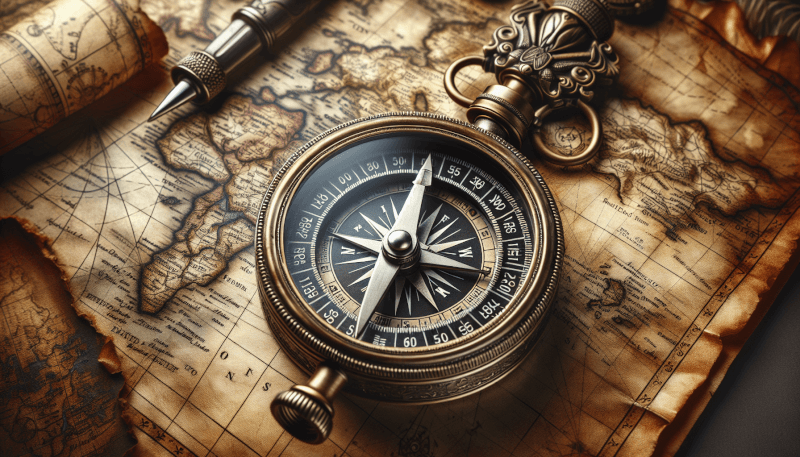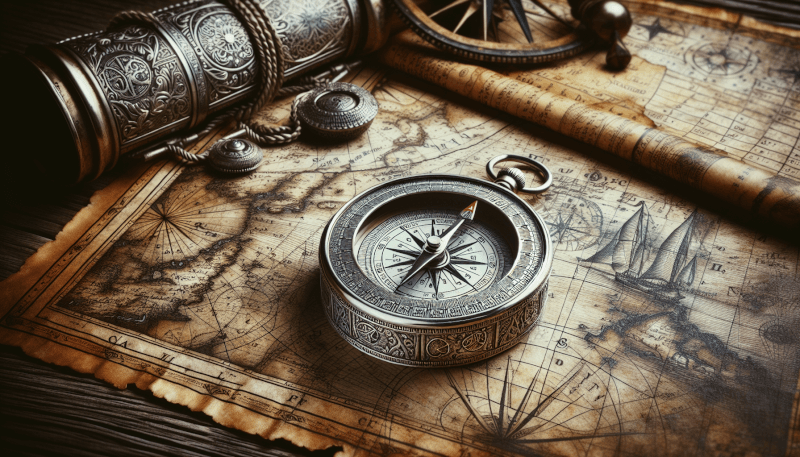Have you ever found yourself lost in the wilderness, with no cellphone signal or GPS to rely on? Fear not, because mastering the art of navigating with a map and compass is the key to finding your way back home. In this article, we will equip you with the knowledge and skills needed to become an expert at using these trusty tools. So strap on your hiking boots and get ready to embark on a journey of exploration and discovery.
Understanding the Basics of Map & Compass
Types of Maps
When it comes to navigating with a map and compass, it’s important to understand the different types of maps that are available. Topographic maps, for example, provide a detailed representation of the land and include contour lines to show the elevation changes. Road maps, on the other hand, focus on highways and road networks, making them ideal for urban navigation. Other types of maps include marine charts for navigation on water and trail maps for hiking and outdoor activities.
Parts of a Compass
A compass is an essential tool for navigation and consists of several key parts. The base plate, which is typically transparent, allows you to see the map underneath. The housing contains the compass needle and the directional markings, showing the cardinal directions (north, south, east, and west). The compass needle itself points towards magnetic north, which is crucial for finding your bearing. Additionally, many compasses have a rotating bezel or a sighting mirror to aid in more advanced navigation techniques.
Map Scales and Symbols
Map scales and symbols are important elements to understand when working with maps. Map scales represent the relationship between the distance on the map and the actual distance on the ground. A scale of 1:24,000, for example, means that one inch on the map represents 24,000 inches on the ground. Symbols, on the other hand, are used to represent different features on the map such as roads, rivers, and buildings. Understanding these scales and symbols will greatly enhance your ability to interpret and navigate using maps.
Navigating with a Map
Orienting the Map
Before you can start using a map to navigate, it’s crucial to properly orient the map. This means aligning the features on the map with the corresponding features in the real world. To do this, you can use a compass to find north and then rotate the map accordingly. Another way to orient the map is by using prominent landmarks in your surroundings as reference points. Once the map is properly oriented, you can confidently navigate from one point to another.
Using a Compass to Find Direction
To find direction using a compass, hold the compass flat in your hand and make sure the compass needle is aligned with the north arrow on the compass housing. Once the needle is aligned, the direction of travel arrow on the compass base plate will point towards the desired direction. This allows you to determine the correct direction to follow when navigating from one point to another. Keep in mind that the compass needle aligns with magnetic north, which may differ slightly from true north due to magnetic declination.
Interpreting Map Features
Understanding and interpreting the features on a map is essential for successful navigation. Contour lines, for example, indicate changes in elevation and can help you identify hills, valleys, and ridges. By paying attention to contour lines, you can plan your route to avoid steep slopes or choose the best route to reach your destination. Other map features, such as water bodies, roads, and landmarks, provide valuable information for navigation. By learning how to interpret these features, you can navigate more efficiently and safely.

Using a Compass
Taking a Bearing
Taking a bearing with a compass is the process of determining the angle between your current location and a target point. To take a bearing, point the direction of travel arrow on your compass towards the target point and rotate the compass housing until the compass needle aligns with the north arrow. The bearing is then read from the degree markings on the compass housing. This allows you to navigate accurately towards your desired destination, even when the route is not clearly marked on the map.
Following a Bearing
Once you have taken a bearing towards your target point, it’s important to continuously refer back to your compass to ensure you stay on course. As you navigate, keep the direction of travel arrow on the compass aligned with the bearing you took earlier. This will keep you on the right track and prevent you from veering off course. By regularly checking your compass and adjusting your direction if necessary, you can confidently navigate towards your desired destination.
Adjusting for Magnetic Declination
Magnetic declination refers to the difference between magnetic north (the direction the compass needle points) and true north (the direction towards the North Pole). This variation can vary depending on your location on the Earth. To adjust for magnetic declination, you need to determine the declination value for your specific area and adjust your compass readings accordingly. Many maps include a declination diagram or a value that you can use for this adjustment. By accounting for magnetic declination, you can ensure that your compass readings align with true north and navigate accurately.
Advanced Navigation Techniques
Dead Reckoning
Dead reckoning is a technique that involves estimating your position based on a previously known position and the direction and distance you have traveled. By using a compass to maintain a constant bearing and keeping track of your speed and time, you can estimate your current position relative to your starting point. Dead reckoning is especially useful in situations where landmarks or clear navigational aids are not readily available. However, it requires careful attention to detail and continuous updates to maintain accuracy.
Triangulation
Triangulation is a method that involves using three known points to determine your exact location. By taking bearings to three visible landmarks and plotting them on a map, you can create intersecting lines that pinpoint your position. This technique is commonly used in more challenging navigation scenarios where multiple reference points are available. Triangulation provides a high level of accuracy but requires careful observation and map interpretation skills.
Pacing and Timing
Pacing and timing are techniques used to estimate distance traveled and the time it takes to reach a certain point. By measuring the distance you cover with each step (pacing) and multiplying it by the number of steps taken, you can estimate the distance you have traveled. Timing involves measuring the time it takes to walk a certain distance or complete a leg of your journey. By combining pacing and timing, you can calculate your average walking speed and estimate the time it will take to reach your destination.

Using Landmarks and Terrain Features
Identifying Prominent Landmarks
Landmarks are key features in the environment that can help you navigate and confirm your current position. These can include mountains, distinctive trees, buildings, or other easily recognizable landmarks. Before setting off on your journey, it’s important to identify prominent landmarks along your route and mark them on your map. By keeping an eye out for these landmarks as you navigate, you can use them as reference points to confirm your location and stay on track.
Navigating with Terrain Features
Terrain features, such as hills, valleys, and water bodies, provide valuable information for navigation. By understanding how these features are represented on a map and observing them in the real world, you can navigate more effectively. For example, if you encounter a hill on your planned route, you can expect an incline and adjust your pace accordingly. By considering the terrain features as you navigate, you can make better decisions and stay on track towards your destination.
Route Planning and Execution
Route planning is an essential part of successful navigation. Before embarking on your journey, take the time to study the map and plan your route. Identify key waypoints, such as intersections or prominent landmarks, that you will encounter along the way. Consider the terrain, distance, and potential obstacles when selecting your route. Once your route is planned, execute your plan by following the map, using your compass, and referring to prominent landmarks and terrain features. Regularly check your progress and make any necessary adjustments to ensure you reach your destination safely.
Navigating in Different Environments
Navigating in Woodlands
Woodlands can be challenging to navigate due to the dense vegetation and lack of distinct landmarks. To navigate effectively in woodlands, it’s important to rely on your map, compass, and terrain features. Look for streams, ridges, or other identifiable features that can help you determine your location on the map. Pay attention to changes in vegetation or elevation to confirm your position. Use trail maps or marked paths whenever possible to maintain your bearings and follow a clear route.
Navigating in Deserts
Navigating in deserts presents a unique set of challenges due to the vast, open landscapes and lack of visible landmarks. In desert environments, it’s crucial to rely heavily on your compass and map. Take accurate bearings towards distant features, such as mountains or distinctive rock formations, and use them as reference points. Pay attention to sand dune formations, wind patterns, or any other features that can help you maintain your bearings. Additionally, carrying extra water and essential supplies is essential when navigating in deserts to ensure your safety.
Navigating on Water
Navigating on water requires specific skills and techniques to ensure a safe journey. Marine charts are essential tools for water navigation as they provide detailed information about tides, currents, and navigational aids. When navigating on the water, it’s important to constantly monitor your position using landmarks, buoys, and other navigational aids. Consider wind and current direction to accurately calculate your drift and adjust your course accordingly. Additionally, always carry appropriate safety equipment, such as life jackets and signaling devices, when navigating on water.

Common Navigation Errors
Getting Lost
Getting lost is a common navigation error that can happen to anyone. It can occur due to a variety of reasons, such as misinterpreting map features, not paying attention to your surroundings, or not taking accurate compass bearings. To prevent getting lost, always take the time to carefully study the map, plan your route, and confirm your bearings. Regularly check your progress with map and compass readings and refer to prominent landmarks and terrain features. If you find yourself off course, retrace your steps or use alternative navigation techniques to get back on track.
Misjudging Distance
Misjudging distance is another common navigation error that can lead to longer journeys or overshooting your destination. This error can occur when you don’t properly account for changes in elevation, difficult terrain, or unexpected obstacles. To avoid misjudging distance, carefully study the map and calculate the distance between waypoints. Consider the terrain and the effort required to traverse it. Take note of prominent landmarks or distinctive features as you navigate to confirm your progress and avoid underestimating or overestimating the distance.
Ignoring Environmental Factors
Ignoring environmental factors is a navigation error that can have serious consequences. Failing to consider factors such as weather conditions, time of day, or wildlife can lead to unsafe situations or getting off track. Always be aware of the weather forecast and its potential impact on your journey. Plan your route and timing accordingly to account for daylight hours and potential changes in weather. Lastly, be mindful of wildlife and any potential hazards in the environment to ensure your safety while navigating.
Staying Safe While Navigating
Sharing Your Itinerary
Sharing your itinerary is an important safety precaution when navigating in remote or unfamiliar areas. Before setting off, inform someone you trust about your planned route, estimated time of arrival, and when they should expect to hear from you. This ensures that someone knows where you are and can raise the alarm if you do not return as planned. In case of an emergency, search and rescue teams will have valuable information to aid in finding you.
Carrying Essential Navigation Equipment
Carrying essential navigation equipment is vital for your safety while navigating. Apart from a map and compass, consider carrying additional equipment such as a GPS device, a whistle for signaling, a headlamp or flashlight for visibility, and a first aid kit. Make sure you are familiar with how to use each piece of equipment and keep them easily accessible. Additionally, dress appropriately for the environment and bring extra clothing, food, and water to sustain yourself in case of unexpected delays.
Using GPS as a Backup
GPS devices can serve as valuable backup tools for navigation. While relying on traditional map and compass skills is important, GPS devices can provide additional navigational information and help pinpoint your current location. However, it’s important to remember that GPS devices may not always be reliable, especially in remote or mountainous areas with limited satellite coverage. Always carry a map and compass as your primary navigation tools and use GPS as a supplemental aid.

Improving Your Navigation Skills
Taking a Navigation Course
Taking a navigation course is a fantastic way to improve your skills and gain confidence in using map and compass. Numerous organizations and outdoor education centers offer courses ranging from basic to advanced navigation techniques. These courses typically cover map reading, compass skills, route planning, and advanced navigation methods. By learning from experienced instructors and practicing in a supportive environment, you can enhance your skills and become more proficient in navigation.
Practicing in Familiar and Unfamiliar Areas
To further improve your navigation skills, it’s important to practice in both familiar and unfamiliar areas. In familiar areas, challenge yourself to navigate without relying on familiar landmarks and instead focus on using your map and compass. This will help you develop a stronger understanding of map interpretation and navigation techniques. In unfamiliar areas, put your skills to the test by exploring new territories and navigating through varying landscapes and terrains. By practicing in different settings, you’ll gain invaluable experience and become a more confident navigator.
Joining a Navigation Group
Joining a navigation group or club is a great way to meet like-minded individuals and continue improving your navigation skills. These groups often organize group hikes or navigation challenges where you can put your skills to the test and learn from others. By participating in group activities, you can exchange knowledge and experiences with fellow navigators, learn new techniques, and explore different areas with a supportive community. This can greatly enhance your navigation skills and provide opportunities for new adventures.
Additional Resources
Books and Reference Materials
There are many books and reference materials available that can further expand your knowledge of map and compass navigation. Some recommended titles include “The Complete Idiot’s Guide to Navigation” by Jim Feather, “Be Expert with Map and Compass” by Björn Kjellström, and “Wilderness Navigation: Finding Your Way Using Map, Compass, Altimeter, & GPS” by Bob Burns. These resources provide detailed explanations, real-world examples, and exercises to help you hone your navigation skills.
Online Navigation Tools
In addition to traditional map and compass navigation, online tools can also be valuable resources for planning and executing your journeys. Websites such as Google Maps, AllTrails, and Outdooractive provide digital maps, trail information, and route planning features. These tools can supplement your traditional navigation skills and offer additional resources for finding trails, identifying landmarks, and estimating distances.
Mapping Apps
Mapping apps on smartphones and tablets have become increasingly popular for navigation. Apps like Gaia GPS, ViewRanger, and Komoot offer detailed digital maps, GPS tracking, and route planning features. However, it’s important to remember that electronic devices may not always have reliable signal coverage or battery life. Therefore, it’s crucial to always carry a physical map and compass as a backup and rely on electronic devices as supplemental tools.
By understanding the basics of map and compass navigation, practicing essential skills, and immersing yourself in the world of navigation, you can become an expert in navigating through various environments. Whether you’re exploring woodlands, deserts, or navigating on water, having a solid foundation in map and compass navigation will empower you to safely and confidently explore the great outdoors. So grab your map, compass, and a spirit of adventure, and embark on your next navigation journey!



